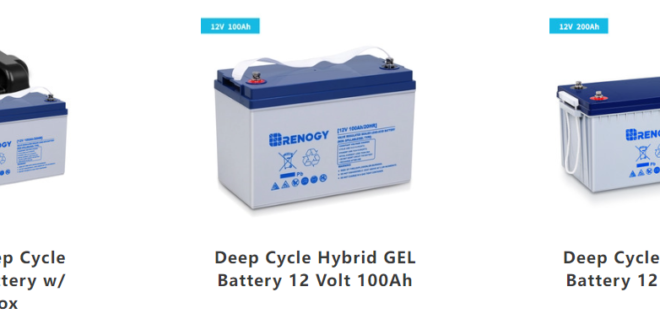Before we get to the point, one fact needs to be highlighted, marine battery is used to power smaller and larger boats and ships. Basically, these are the same batteries that are used in mobile homes. Since boats are subject to strong movement from the waves, it is important that the supply battery is vibration and leak-proof. That is why AGM and GEL batteries are preferred here. They have the highest reliability, especially in rough seas. Let’s take a closer look at the differences.
This is how boat batteries work
Boat battery are mostly lead batteries. The charged electrodes consist of lead and lead dioxide. Sulfuric acid is used as the electrolyte. The advantages of lead-acid batteries are their service life of up to ten years, their reliability and their low price. Small disadvantages are the comparatively high weight and the relatively low energy density.
Another special feature is the different construction methods. There are open and closed systems for lead-acid batteries. With the open systems, you can feed back the portion of the water that evaporates as a result of the heating. In closed systems this is not possible and not necessary. Here the gas recombination rate is about 95 percent. Because of this, you don’t need to refill the battery throughout its lifetime.
Two main types of lead-acid batteries are used to power boats: AGM batteries and GEL batteries.
AGM batteries for boats
What is a AGM battery? The AGM battery is a sealed battery whose electrolyte is embedded in a fiberglass fleece. This technology significantly reduces the self-discharge rate of the battery. A top-up is only required every six months. Furthermore, AGM batteries are absolutely leak-proof and can be installed in a wide variety of positions. The battery type is particularly well suited for small boats in particular.
The fleece also offers the advantage that the ions are slowed down much less than with GEL batteries, for example. This means that they can be charged faster and can provide higher currents. With these properties, AGM batteries are suitable for many different applications such as caravans, motorcycles, cars, electric vehicles and boats. This is mainly due to the fact that more and more vehicles are being equipped with start-stop systems. The frequent switching on and off represents a considerable load, which is why a resistant battery is necessary. Conventional batteries would not withstand this heavy use. AGM batteries, on the other hand, can easily withstand thousands of charges.As we know, A complete off-grid solar system consists of the following important components: solar panels, solar generators, solar inverters, charge controllers, and other important spare parts
Further advantages at a glance:
high positional stability
no recharging required in winter
low internal resistance
insensitive to deep discharge
high cycle stability
very well suited for start-stop systems
also withstands many charging cycles without any problems
GEL batteries for boats
Boat GEL battery has silica in its electrolyte. This gives it a viscous consistency. This in turn prevents acid stratification, segregation and thus a loss of capacity. Furthermore, GEL batteries are completely sealed systems. No water can be refilled here. However, this is not necessary and has many advantages. The batteries are lighter and easier to transport. However, the internal resistance is higher. Therefore, GEL batteries are not optimally suited to deliver high currents.
If the GEL battery is not charged, a layer of lead sulphate forms on the electrodes. On the other hand, when the battery is charged, porous lead forms on the negative electrode. One also speaks of lead sponge. Electrical energy is generated during charging and discharging. Fine cracks form in the GEL, which act as channels. The oxygen can thus reach the negative electrode more easily. There it then combines with hydrogen to form water. Oxyhydrogen gas is produced as a by-product of this process, but this can easily be released via a valve.
With GEL batteries, the acid density does not drop as much during deep discharge as with AGM batteries. However, since the service life always depends on the degree of discharge, the charge level of the batteries should never drop below 50%. If you need more energy for a short time, it is therefore important to recharge the battery quickly.
Various areas of application
One of the biggest advantages of GEL batteries is that they do not emit any harmful gases. This makes them particularly suitable in areas where full ventilation cannot be provided, where there are many people or machines. GEL batteries are also well suited to areas where stricter environmental protection regulations apply. The areas of application for GEL batteries are correspondingly diverse:
quad batteries
motorcycles
cars
mobile homes
quad
wheelchairs
Warning, emergency power and telephone systems
I have attached an overview of the advantages of the batteries for you:
high power peaks
cheap price
robust production method
low maintenance
high resilience
particularly suitable for use in the PV sector
What to look out for when choosing marine deep cycle batteries
Basically, AGM batteries are best suited for boats. This is mainly due to their resilience and flexibility. They can be installed in a wide variety of positions and are absolutely leak-proof. The most important thing here is the capacity. You can calculate it like this:
Divide the power of the consumer (e.g. 100 watts) by the battery voltage (e.g. 12 volts) The result is the necessary electricity. You multiply the current required by the switch-on time. You then multiply the calculated ampere-hours by the safety factor. This is 1.3 for lead acid and 1.5 for GEL. The result is the required capacity. Let’s go through this with an example. Let’s assume you have a motor with a power of 160 watts and a voltage of 12 volts. The current required in this case would be 13.33 amps. If we now multiply the value by an assumed operating time of six hours and the safety factor, we arrive at a value of 100 – 120 ampere hours. Your new battery should have at least this value.
 HammBurg Be informed with latest news, reviews, entertainment, lifestyle tips, and much more.
HammBurg Be informed with latest news, reviews, entertainment, lifestyle tips, and much more.




